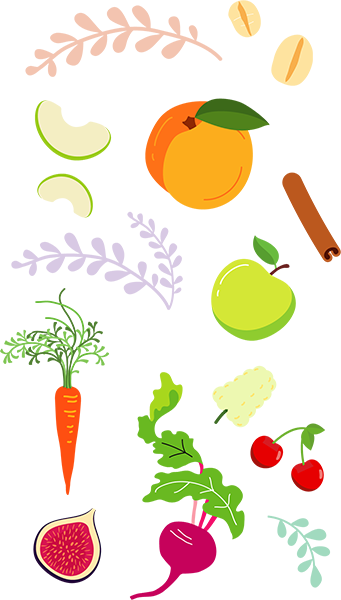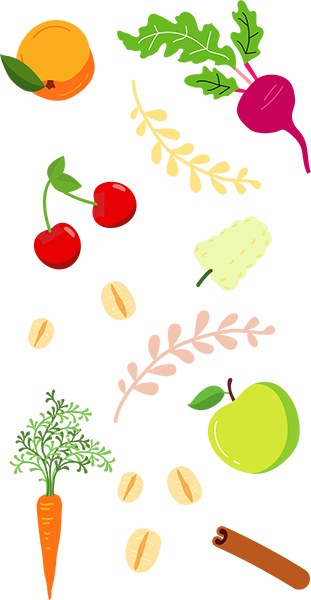The humble vegetable. A crucial part of a balanced diet.
Shirked by many and loved by the few for so long it is great to see an increased appetite for our “greens” as the numbers of vegan and vegetarians grow in response to health, environmental and animal welfare concerns.
So how many vegetables should we be eating as part of a balanced diet?
Whilst I say “the more the merrier”, you can’t eat too many did you know there is an extraordinary effect of eating too many carrots which is a yellowish discolouration of the skin, a condition called carotenemia, which is most noticeable on the palms and soles! Sounds extraordinary doesn’t it.
So perhaps we take heed of the government dietary guidelines which suggest we should be eating a minimum of 400g of vegetables everyday as adults or 5 x 80g portions. We are reminded of this with the unforgettable “one of your 5 a day” slogan which we are all familiar with on product packaging.
Fruit and vegetables should make up half your plate at any given meal – approximately 30% vegetables and 20% fruit so we are told.
But how easy do you find this?
For many this is a simple and enjoyable undertaking but I believe this is down to being able to prepare and/or cook our vegetable friends in a delicious flavour filled way. This can often be a great skill with the average lack lustre specimens we find in our supermarket that have often been picked weeks before they land on your plate.
I believe the key to increasing your intake of vegetables is to choose locally sourced and seasonal varieties.
You can immediately taste the difference between a carrot grown by your local farm shop or vegetable box provider and the ones from your supermarket. Most importantly as an advocate for organic you are more likely to find truly organically grown vegetables in these places whose taste isn’t hindered by a barage of chemicals.
Carrots that actually taste of carrot! Amazing.
Equally it is important to remember as we begin to reduce our salt and sugar intake in our diets our taste buds are heightened once more and the subtle flavours of vegetables that have been lost from us due to our diet then return.
So now we have rediscovered our interest in vegetables how can we more easily incorporate them into our diet?
Here are a few ideas to inspire you.
Savoury and Sweet
When we think of a vegetable we often think of them as savoury additions when in fact so many vegetables are very versatile and can be incorporated into a variety of more sweet dishes.
Beetroot for example works well in brownies, carrot in cake and biscuits, courgette in muffins.
Often their use minimizes the use for excess sugar and binders and forms a welcome high fibre addition.
Take a look at the recipes on our website for some great ideas to inspire you such as our carrot waffles!
Whilst at PK we make muesli using you can likewise try grating fresh carrot and apple into your bowl of oats and soak them over night as a bircher mixed with warming spices of cinnamon and ginger for a wholesome start to your day.
Sunday Preparation
So often the time factor has a huge part of play on our creativity and inclusion of vegetables in our diet. A nice way to overcome this whilst also providing yourself with easy lunch options for the week is to prepare 3 or 4 chosen vegetables on a Sunday and store in boxes to make up a healthy meze during the week. Roasted sweet potatoes, peppers and courgettes work well for this mixed with herbs and spices.
Vegetable noodle anyone?
Often the way we prepare our vegetables can turn them into something else! What do I mean by this?
Well.. courgettes and sweet potato can be spiralised into noodles which combined with a nice sauce could replace flour noodles and pasta.
Cauliflower can be breadcrumbed and used as a flour or rice substitute. There are some great recipes for cauliflower pizza now.
Even simply grating carrot and beetroot together can make it more palatable as a salad addition topped with some crunchy roasted seeds.
Go Raw
Fresh, raw vegetables are very high in enzymes which are crucial for optimum digestion and often far more flavoursome often than the cooked ones. Snack on carrots, celery, cucumber, thinly sliced beetroot, radishes dipped into hummus, dukkah or runny cheese and nibble on freshly podded peas and broadbeans in season. Delicious…
Blend
If you prefer the art of disguise then blending might be the answer, either into a smoothie, juice or soup.
Now it is summer time why not try a refreshing gazpacho.
Or check out a smoothie recipe from our website.
Absorption
When we think of getting our vegetables down us we think of putting them in our mouth but another organ of assimilation is our skin.
We forget our skin is the largest organ of our body and absorbs what it touches. Therefore we can absorb nutrients and benefits of vegetables when we use them on our skin.
Some great examples of these are:
Avocado face mask – used by the Mayans as an anti-wrinkle cure this leaves the skin feeling super soft as it absorbs the vitamin A and E within it.
Cucumbers pureed with a little honey are cooling and hydrating for the skin reducing redness.
And thats a wrap..
My last contender is a clever replacement for bread. A Korean concept but easily adopted, the art of using seaweed sheets or lettuce leaves to wrap your sandwich ingredients. Especially good if you have gone gluten free or given up bread!
It is Summer so there is no better or more abundant time to go green and be experimenting with delicious seasonal vegetables.
But if all else fails you can always reach for a bowl of our muesli!
X Primrose
With so much information at our finger tips via the web, podcasts and books that is often contradictory it can sometimes be overwhelming to know what are ultimately the best food choices for your health.
In order to lessen our reliance on these channels of information as well as moving away from our own often critical overthinking of our food choices we need to spend time developing our relationship with ourselves and our own body. This can also be called developing your intuition.
The definition of intuition is “the ability to understand something instinctively, without the need for conscious reasoning”.
Our brain is usually the one in charge, calling the shots, instead we need to allow our body to guide us to the correct outcome, using it like a dowser uses a pendulum for an answer.
If this is something that comes naturally to you then great if it doesn’t don’t worry, what is wonderful about our intuition is that it can be developed by all of us with some awareness and intention over time. The most important element is learning to trust ourselves which can often be easier said than done.
Often with our busy lives we don’t have time to slow down and really listen and notice the subtleties of symptoms our body may develop from eating certain foods over others. Left unnoticed these symptoms can turn into intolerances.
One thing that this recent lockdown has enabled I believe is for a reconnection to nature. When we reconnect to nature we reconnect to ourselves and what makes us feel good and what doesn’t. This enables us to better gauge when we feel we are in balance and when we are not quite and instead of ignoring these subtle changes we can look for ways to rectify them.
So what is intuitive eating?
Intuitive eating is is a framework for helping us establish a better relationship to food, our body image and movement.
It involves eliminating the word diet from our repertoire and practising an unconditional self acceptance and compassion towards ourselves so when we are struggling with food we have the strength to overcome it.
Rather than wanting to be the perfect weight and determining your self worth on what you have eaten or managed not to eat it is about accepting the beautiful person that you are.
Key steps to an intuitive eating way of life are as follows:
Respect satiety
In order to avoid overeating it is important to listen to your body when it is feeling full. Eat slowly and chew your food. Maintain hydration levels during the day so when you eat you are not dehydrated and compensating with food.
Listen to Hunger
Hunger is an important natural function of the body.
During your everyday don’t wait till you are starving to eat. Your body doesn’t know the difference between food scarcity and starvation so will compensate for you starving yourself by slowing down the metabolism to conserve energy which can lead to weight gain.
Watch your emotions
We all know it is a disaster to go to the supermarket when we are hungry as our emotions are strong and we end up making impulsive usually more unhealthy food choices but how often do we watch how our eating fluctuates with our other emotions? Become consciously aware of when this happens and consider other methods of soothing yourself that don’t involve food.
Move from emotive eating to mindful eating. Slow down, savour and enjoy the subtle flavours of the food and appreciate each mouthful.
Avoid reactive and habitual behaviour
Be conscious and be guided to what makes your body feel good rather than following habitual behaviour.
Walk down the aisle and feel your way towards the variety of different vegetables and fruit. What do you feel like? What does your body want?
Rather than doing the same shop every week for the same set of meals you do every week focus on variety.
Seasonal
Following the food that is in season is a great and simple starting point for this intuitive eating journey. Eating what is in season means eating what is grown in your local area, it has travelled the least distance and has the most nutrition. It is also most likely to be closest to what our ancestors were eating at that time and as it is grown in the same soil that we live on if often high in the minerals and nutrients we actually need as we are intrinsically connected to our environment whether we realise it or not.
Permission
Neutralise your attitude towards food and give yourself permission to eat any food that you want. By restricting certain things you will end up craving them more and put them in the “bad for me” box. An intuitive diet is about moderation. Sometimes the magnesium in chocolate is exactly what your body needs and you should listen to it!
Exercise in the moment
When you are exercising don’t be highly focussed on the outcome you want to achieve but focus on how you feel whilst you are doing it. Focus on what your body likes and what it doesn’t and adapt from there.
Don’t forget that eating should be a pleasurable and satisfying experience.
Allow it be that for you by not diminishing it to what is on your plate, become aware of the environment or company as part of your eating experience and make necessary changes so that it supports you best.
I leave you with a quote from Amanda Levitt (writer and activist)
X Primrose
“ It sometimes is as simple as reminding myself that my body is a good body, that all bodies are good bodies”


